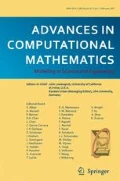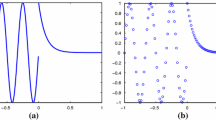Abstract
Edge detection from a finite number of Fourier coefficients is challenging as it requires extracting local information from global data. The problem is exacerbated when the input data is noisy since accurate high frequency information is critical for detecting edges. The noise furthermore increases oscillations in the Fourier reconstruction of piecewise smooth functions, especially near the discontinuities. The edge detection method in Gelb and Tadmor (Appl Comput Harmon Anal 7:101–135, 1999, SIAM J Numer Anal 38(4):1389–1408, 2000) introduced the idea of “concentration kernels” as a way of converging to the singular support of a piecewise smooth function. The kernels used there, however, and subsequent modifications to reduce the impact of noise, were generally oscillatory, and as a result oscillations were always prevalent in the neighborhoods of the jump discontinuities. This paper revisits concentration kernels, but insists on uniform convergence to the “sharp peaks” of the function, that is, the edge detection method converges to zero away from the jumps without introducing new oscillations near them. We show that this is achievable via an admissible class of spectral mollifiers. Our method furthermore suppresses the oscillations caused by added noise.
Similar content being viewed by others
References
Archibald, R., Gelb, A.: Reducing the effects of noise in image reconstruction. J. Sci. Comput. 17(1–4), 167–180 (2002)
Canny, J.: A computational approach to edge detection. IEEE Trans. Pattern Anal. Mach. Intell. 8, 679–698 (1986)
Engelberg, S., Tadmor, E.: Recovery of edges from spectral data with noise—a new perspective. SIAM J. Numer. Anal. 46(5), 2620–2635 (2008)
Gelb, A., Cates, D.: Detection of edges in spectral data III—improvements in the presence of noise. J. Sci. Comput. 36(1), 1–43 (2008)
Gelb, A., Tadmor, E.: Detection of edges in spectral data. Appl. Comput. Harmon. Anal. 7, 101–135 (1999)
Gelb, A., Tadmor, E.: Detection of edges in spectral data II. Nonlinear enhancement. SIAM J. Numer. Anal. 38(4), 1389–1408 (2000)
Gelb, A., Tadmor, E.: Adaptive edge detectors for piecewise smooth dara based on the minmod limiter. J. Sci. Comput. 28(2–3), 279–306 (2006)
Gottlieb, D., Shu, C.W.: On the Gibbs phenomenon and its resolution. SIAM Rev. 39(4), 644–668 (1997)
Hesthaven, J.S., Gottlieb, S., Gottlieb, D.: Spectral Methods for Time-dependent Problems. Cambridge University Press (2007)
Shu, C.-W.: Essentially non-oscillatory and weighted essentially non-oscillatory schemes for hyperbolic conservation laws. Advanced Numerical Approximation of Nonlinear Hyperbolic Equations, vol. 1687 of Lecture Notes in Mathematics, pp. 325–432 (1998)
Petersen, A., Gelb, A., Eubank, R.: Hypothesis testing for Fourier based edge detection methods. J. Sci. Comput. (2011, accepted)
Sobel, I.: An isotropic 3×3 image gradient operator. In: Freeman, H. (ed.) Machine Vision for Three-dimensional Scenes. Academic Press, Boston (1990)
Stefan, W., Viswanathan, A., Gelb, A., Renaut, R.: Sparsity enforcing edge detection for blurred and noisy Fourier data. (2011, submitted)
Stein, E., Weiss, G.: Introduction to Fourier Analysis on Euclidean Spaces. Princeton University Press, Princeton (1971)
Tadmor, E.: Filters, mollifiers and the computation of the Gibbs phenomenon. Acta Numer. 16, 305–378 (2007)
Author information
Authors and Affiliations
Corresponding author
Additional information
Communicated by Yuesheng Xu.
A. Gelb and D. Cochran were supported in part by NSF-DMS-FRG award 0652833. Y. Wang was supported in part by NSF-DMS awards 0813750 and 1043034.
Rights and permissions
About this article
Cite this article
Cochran, D., Gelb, A. & Wang, Y. Edge detection from truncated Fourier data using spectral mollifiers. Adv Comput Math 38, 737–762 (2013). https://doi.org/10.1007/s10444-011-9258-4
Received:
Accepted:
Published:
Issue Date:
DOI: https://doi.org/10.1007/s10444-011-9258-4




